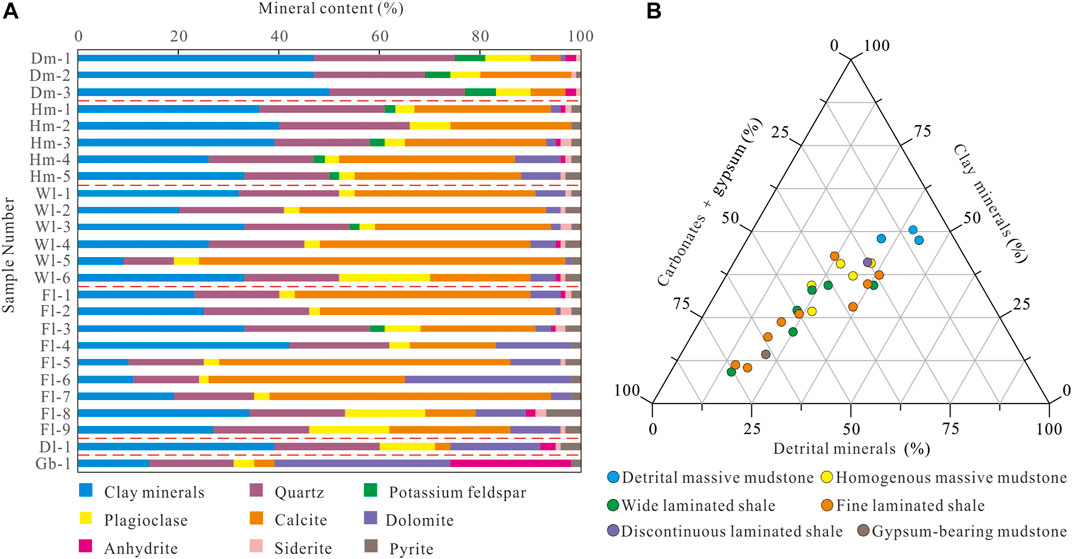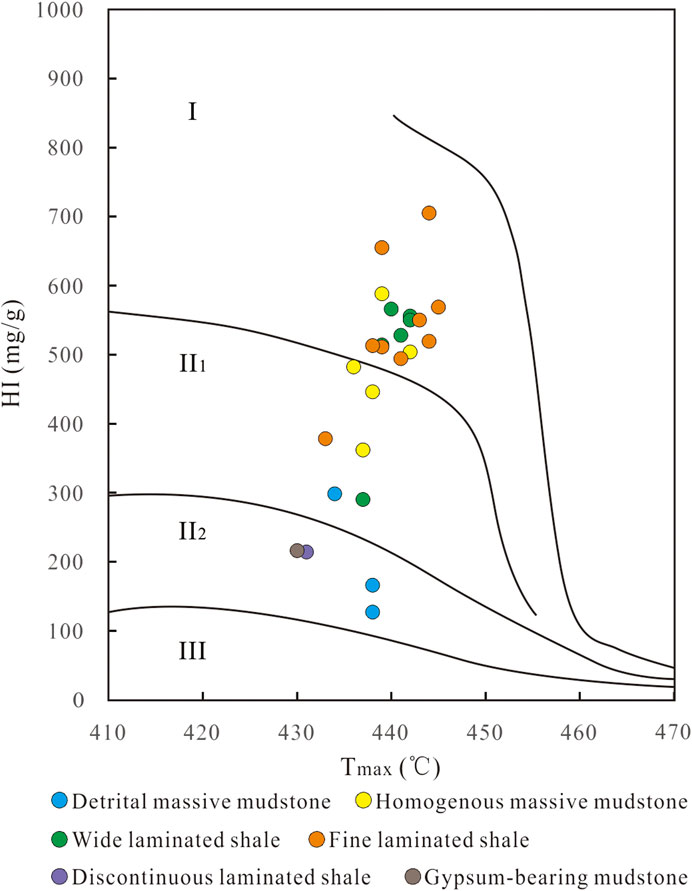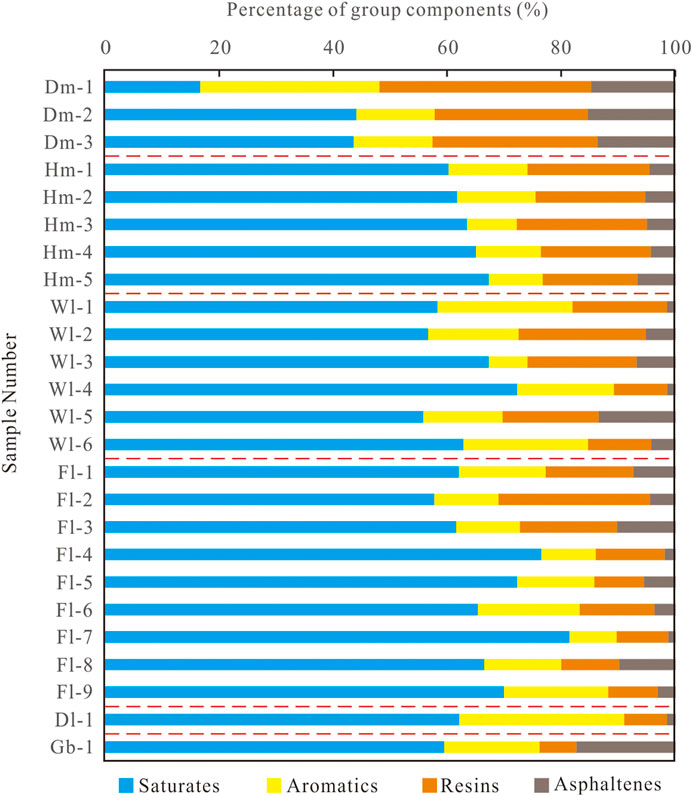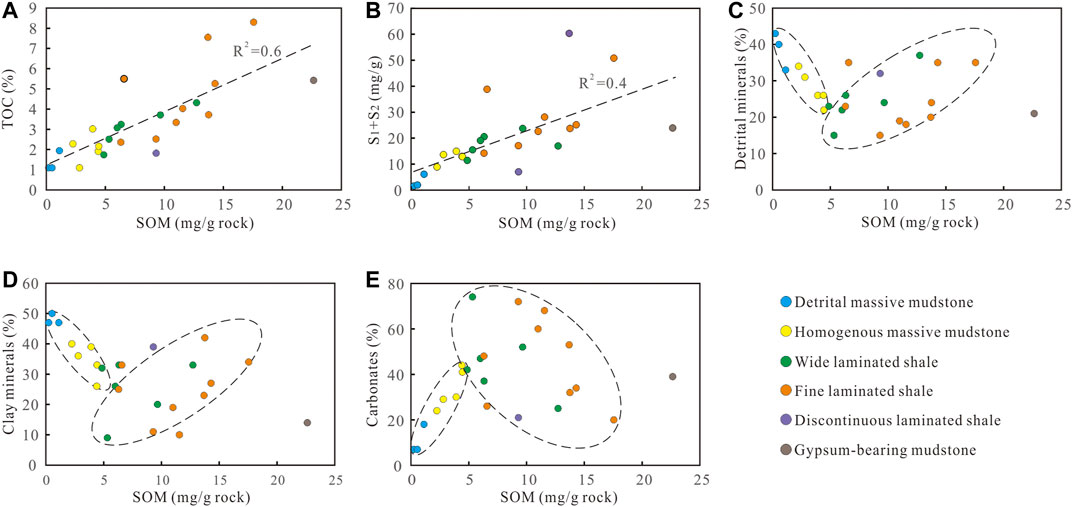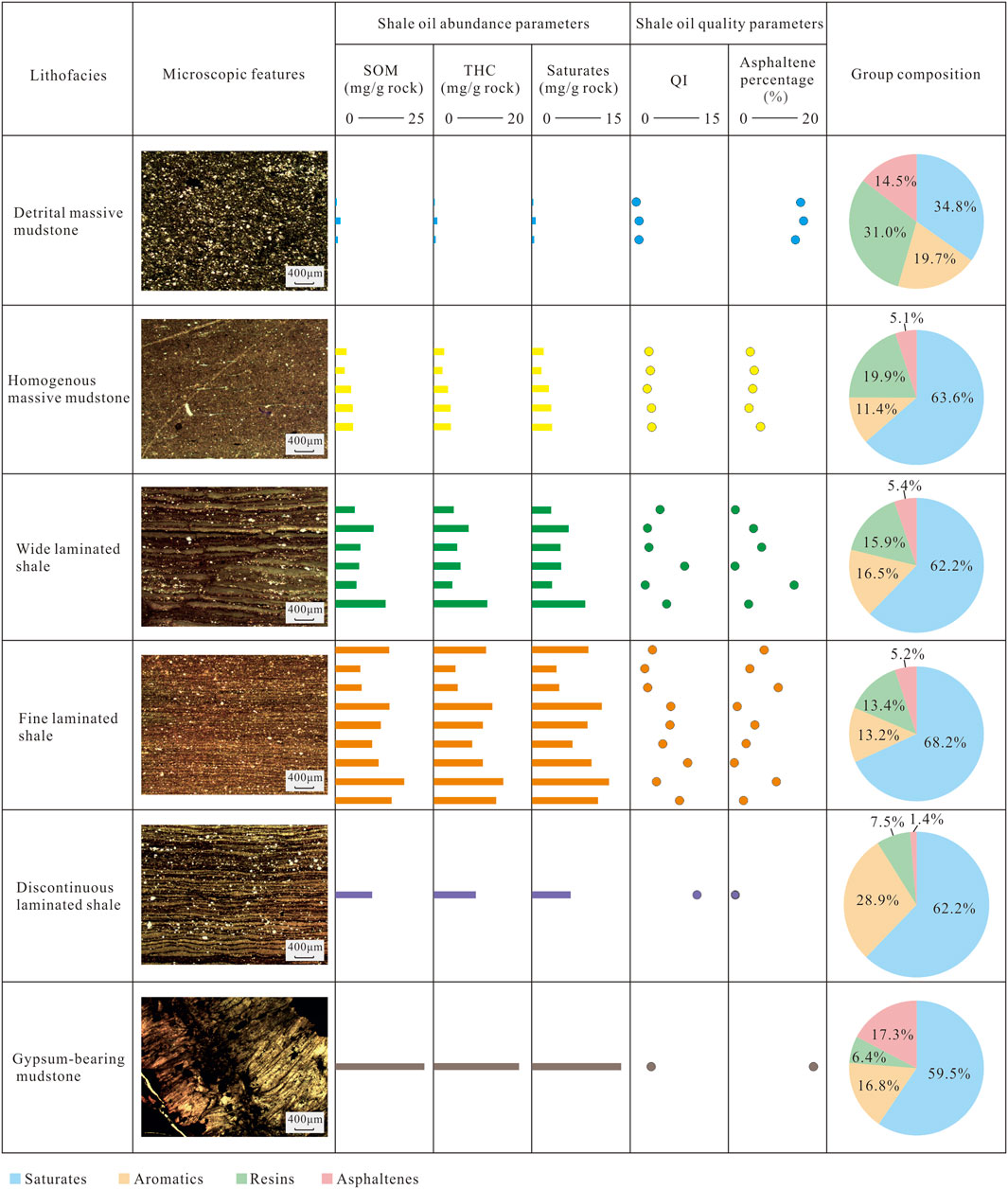The Role of Soluble Organic Matter in Shale Oil “Sweet Spots” Prediction: An Investigation of Shale With Different Lithofacies in the Dongying Sag
- 1State Key Laboratory of Marine Geology, Tongji University, Shanghai, China
- 2Research Institute of Exploration and Development, Shengli Oilfield Company, Dongying, China
Lithofacies are the fundamental geological units for shale oil and gas exploration and development, and soluble organic matter (SOM) is most similar to crude oil in composition. Both aspects attract our attention in the interpretation of SOM in different lithofacies, which can provide direct evidence to predict shale oil “sweet spots”. Here, twenty-five shale samples were collected from the Eocene Shahejie Formation in the Dongying Sag and were subjected to X-ray diffraction, Rock-Eval pyrolysis, and SOM characterization. Comparison of the SOM contents in shales with different lithofacies revealed remarkable differences: 1) The contents of SOM, saturates and total hydrocarbons (THC) showed the order of detrital massive mudstone < homogenous massive mudstone < wide laminated shale < discontinuous laminated shale < fine laminated shale < gypsum-bearing mudstone, and the SOM content was controlled by lithofacies through differences in both OM and minerals. 2) The SOM in detrital and homogenous massive mudstones was mainly composed of saturates and resins. Saturates were the main component in wide and fine laminated shales. The SOM in discontinuous laminated shale was mainly composed of saturates and aromatics. The SOM in gypsum-bearing mudstone was mainly composed of saturates, and the percentage of asphaltenes was quite high. Based on the evaluation parameters of high-quality lithofacies in terms of abundance (i.e., SOM, THC or saturate contents) and quality (i.e., quality index and asphaltene percentage), the fine, wide and discontinuous laminated shales were regarded as relatively favorable lithofacies. Based on the lithofacies combination, the fine, wide and discontinuous laminated shales in Es3x and Es4ss (upper section of Es4s) in the Dongying Sag were interpreted as “sweet spots” for shale oil exploration and development. Thus, it is of great significance to study the characteristics of SOM in shale with different lithofacies for shale oil exploration and development.
Introduction
Shale oil and gas has become a hot topic in the exploration and development of unconventional oil and gas resources around the world and has attracted wide attention from petroleum geologists (Jarvie, 2012; Wang et al., 2015; Misch et al., 2016; Kumar et al., 2017; Chen et al., 2018; Wang et al., 2020; Zou et al., 2020; Hou et al., 2021a). A lithofacies is a rock type or rock combination that forms in a certain sedimentary environment and is the main component of sedimentary facies (Yang et al., 2015). As fundamental units representing the sedimentary environment, lithofacies are mainly identified by rock color, composition, structure and other characteristics (Xie, 2009; Zhang J et al., 2016). Moreover, lithofacies are the fundamental geological units for well logging identification, stratigraphic correlation and reservoir evaluation in shale oil and gas exploration and development (Yang et al., 2015; Zhang et al., 2015; Zhang Y et al., 2016). Thus, lithofacies are of great significance to unconventional petroleum geology.
During different sedimentary stages, shale is significantly affected by its ambient physical, chemical and biological environments and can be grouped into various types of lithofacies with distinct characteristics (Seville et al., 2000; Bennett et al., 2012; Zeng et al., 2017). Many researchers have classified shale lithofacies under different rules and discussed their origin, sedimentary environment, hydrocarbon generation potential, reservoir space and diagenetic evolution (Hickey and Henk, 2007; Loucks and Ruppel, 2007; Xie, 2009; Abouelresh and Slatt, 2012; Fu et al., 2013; Wang et al., 2014; Wang et al., 2016; Zhang J et al., 2016; Zeng et al., 2017; Liang et al., 2018). Within shale, soluble organic matter (SOM) is an important product of hydrocarbon generation (Zhu et al., 2016). Normally, SOM extracted by organic solvents is mainly free in pores and physically adsorbed onto mineral surfaces (Rumpel et al., 2005; Pan and Liu, 2009; Wei et al., 2014; Zhu et al., 2016; Hou et al., 2021b), and has a composition similar to that of crude oil (Song et al., 2013; Liu et al., 2014). However, few reports have been made on the characteristics of shale oil in different lithofacies. As a consequence, understanding shale SOM in different lithofacies can help to understand the crude oil in shale and is beneficial to selecting a lithofacies that can generate high-quality shale oil. In this paper, the lithofacies that can generate high-quality shale oil is termed high-quality lithofacies.
In the present study, we selected typical shale samples from the Shahejie Formation in the Dongying Sag and employed different methods to 1) compare the differences in shale SOM in different lithofacies; 2) clarify the factors controlling the shale SOM content in different lithofacies; and 3) establish the evaluation parameters of high-quality lithofacies and predict shale oil “sweet spots”. Our results are practical and significant to shale oil exploration and development.
Samples and Methods
Samples
The Dongying Sag is a secondary structural unit in the Jiyang Depression in the Bohai Bay Basin (Figure 1) (Li et al., 2015; Zeng et al., 2017). A large suite of lacustrine shale was developed in the upper fourth submembers (Es4s, which can also be divided into Es4sx and Es4ss from bottom to top), lower third submembers (Es3x) and middle third submembers (Es3z) of the Eocene Shahejie Formation (Figure 1), which is the main source rock in the sag (Zhang et al., 2009; Zeng et al., 2017). In particular, several industrial oil-flow wells of shale oil have been developed in Es4s and Es3x in the sag (Zhang et al., 2008; Zhang L et al., 2012; Li, 2014; Bao et al., 2016). In the sag, the lithologies and sedimentary environments of the shales in different members are quite different (Zeng et al., 2017): 1) Massive mudstone and gypsum mudstone are developed in Es4sx, which comprises intermittent saltwater lake sediments; 2) gray-black oil shale and laminated shale are developed in Es4ss, which comprises perennial closed saltwater lake deposits; 3) a set of black shale and oil shale are present in Es3x, which comprises brackish and deep lake deposits; and 4) massive mudstone and siltstone are developed in Es3z, indicating that the lake was markedly shallower.
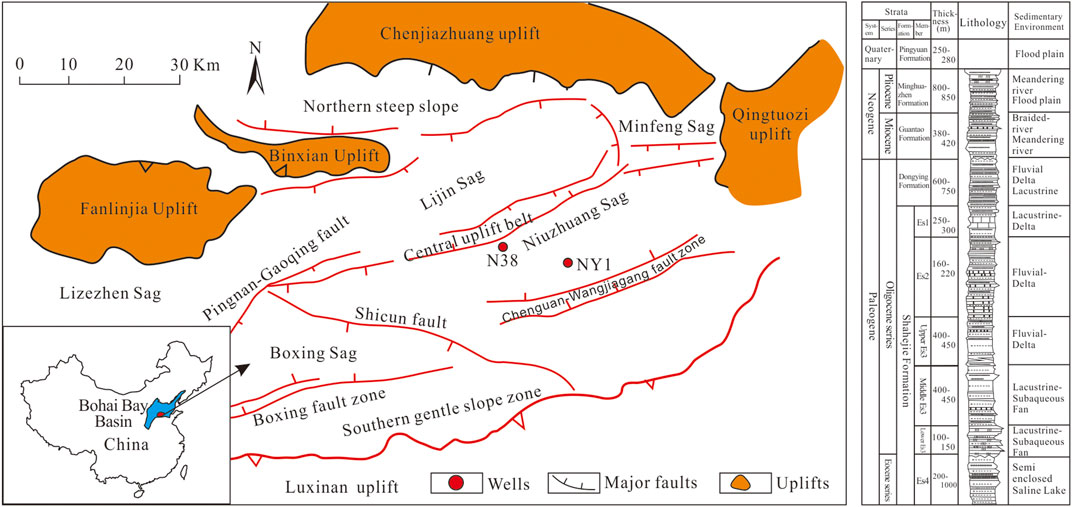
FIGURE 1. Location, structural map and stratigraphic column of the Dongying Sag, modified after Zeng et al., 2017.
In this study, shale core samples from depths of 2,954–3,496 m are selected from Es4s, Es3x and Es3z from wells NY1 and N38 in the Dongying Sag (Figure 1). Sixteen samples from well NY1 were distributed in Es4s and Es3x, and nine samples from well N38 were distributed in Es3x and Es3z. These studied shales have been grouped into different lithofacies, and the lithofacies classification integrates the shale rock type, mineral composition, sedimentary structure, and OM characteristics (Zeng et al., 2017). Overall, there were six types of lithofacies: fine laminated shale (Fl), wide laminated shale (Wl), discontinuous laminated shale (Dl), homogenous massive mudstone (Hm), detrital massive mudstone (Dm) and gypsum-bearing mudstone (Gb) (Figure 2; Supplementary Material). It should be noted that there was only one sample for the discontinuous laminated shale or gypsum-bearing mudstone, resulting in that the comparisons from these two lithofacies were limited in the present study.
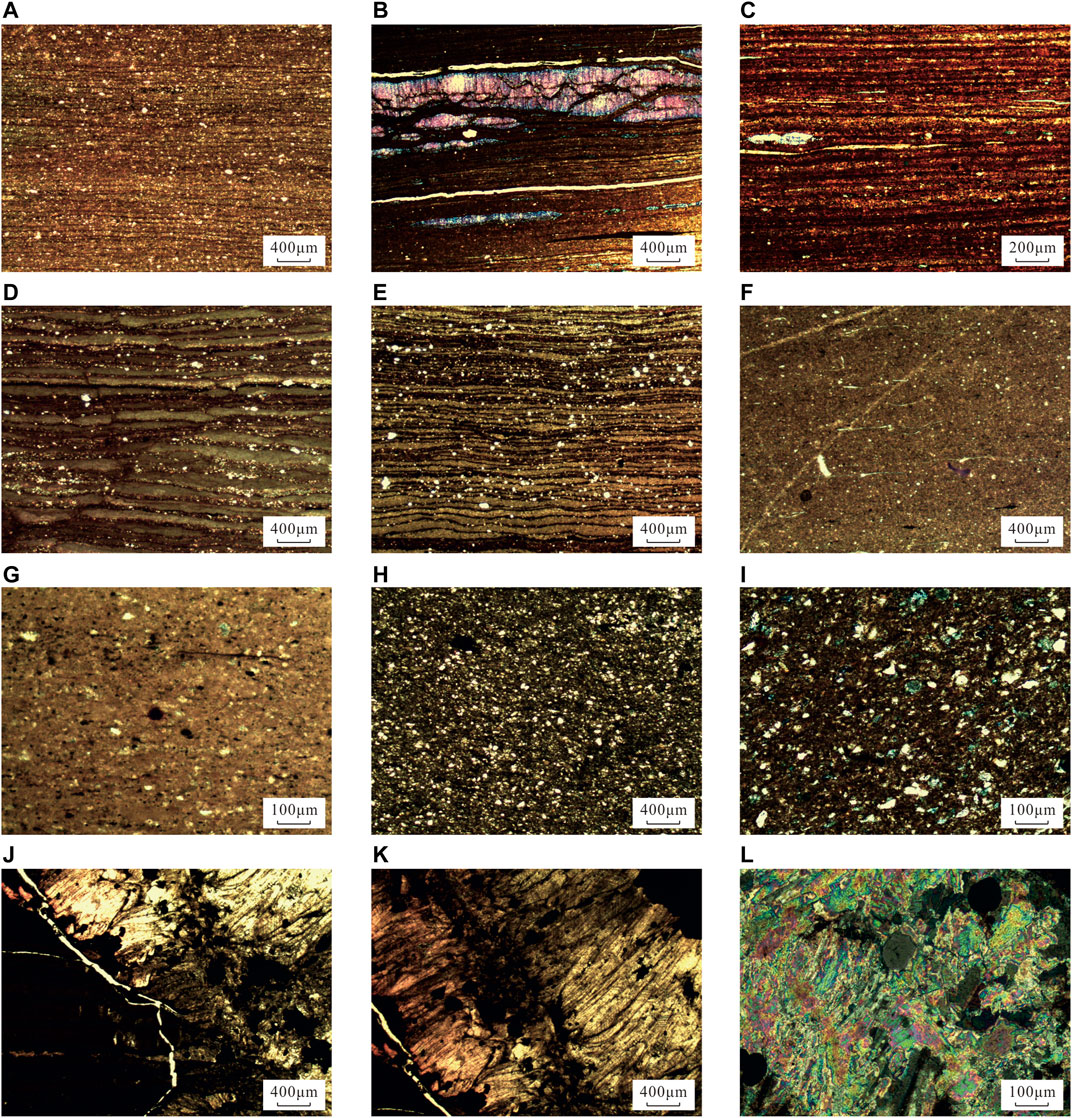
FIGURE 2. Microscopic photographs of shale samples from the Dongying Sag. (A) Organic and argillaceous laminae interbedded in fine laminated shale. (B) Sparry calcite developed in fine laminated shale. (C) Fine laminated shale. (D) Carbonate and argillaceous laminae interbedded in wide laminated shale. The carbonate laminae were partially lenticular. (E) Organic laminae distributed in argillaceous matrixes in discontinuous laminated shale. (F) Homogenous massive mudstone mainly composed of argillaceous minerals with no obvious layers. (G) Detrital particles distributed in a dispersed manner in homogenous massive mudstone. (H) Detrital particles dispersed in argillaceous matrixes in detrital massive mudstone. (I) Detrital massive mudstone. (J) Gypsum-bearing mudstone. (K) Anhydrite veins developed in argillaceous matrixes. (L) Gypsum under orthogonal light.
X-Ray Diffraction
X-ray diffraction (XRD) was used to examine the mineral composition of the original shale samples. The XRD analyses were performed under an X’PERT-PRO-MPD diffractometer (PANalytical, Amelo, Netherlands) using a CuK X-ray tube at 40 mA and 40 kV with a curved graphite monochromator. The CuK α radiation wavelength was 1.540,596 Å. The scattering slit was 1°, and the receiving slit was 0.3 mm. Each oriented slide was scanned from 3 to 30°2θ at 2°2θ/min using a step width of 0.02°2θ. The randomly oriented powder mounts were scanned from 3 to 40°2θ at 2°2θ/min using a step width of 0.02°2θ.
Pyrolysis
Powdered original shale samples (50 mg) were pyrolyzed by using a RockEval six pyrolysis apparatus (Vinci Technologies, France). The powdered samples were first subjected to a 3 min isotherm at 300°C, at which free hydrocarbons were volatilized (peak S1, mg/g rock). Then, programmed pyrolysis at 50°C/min to 600°C was performed to determine the amount of potential hydrocarbons that were released by the thermal cracking of OM (peak S2, mg/g rock). Simultaneously, the CO and CO2 that were released during the thermal cracking of organic oxygen-bearing compounds between 300 and 390°C were measured by a thermal conductivity detector (TCD). This product was reported in mg CO2/g rock and was referred to as the S3 peak. A fourth peak, S4 (mg CO2/g rock), refers to the combustion of residual carbon under an air atmosphere at 600°C. Total organic carbon (TOC) and the hydrogen index (HI) were computed from the S1, S2, and S4 peaks and were reported in weight percent. Tmax corresponded to the temperature at the maximum S2.
Organic Solvent Extraction
Organic solvent extraction was conducted to obtain the SOM in accordance with Zhu et al. (2016). The original shale samples were ground to a particle size of less than 0.18 mm. Shale samples (>50 g) were weighed and placed in a Soxhlet extractor. n-Pentane and dichloromethane were successively used for more than 72 h to extract and collect SOM within shale samples. The group components were separated by column chromatography (see Column Chromatography). Finally, the SOM and group components were accurately quantified using a balance with a precision of 1/10,000, and their contents in the shale samples were calculated.
Column Chromatography
Column chromatography has been widely used for the separation of group components of SOM and crude oil (Pan et al., 2005; Wei et al., 2012; Yang Y. et al., 2015). In this study, the SOM extracted by organic solvents was separated into saturates, aromatics, resins and asphaltenes by using conventional column chromatography. The adsorbent was a mixture of silica gel and alumina. The silica gel was extracted with chloroform until there was no fluorescence. Then, the silica gel was activated by heating in an electric oven at 150°C for 8 h. The neutral alumina was activated by heating in a muffle furnace at 450°C for 6 h. The eluents were n-pentane, dichloromethane and methanol.
Results
X-Ray Diffraction
The XRD analysis showed that the bulk minerals of the studied shales were mainly composed of clay, quartz, feldspar and carbonate with minor amounts of anhydrite, siderite and pyrite (Figure 3A; Supplementary Table S1). The mineral phases of the studied shales were classified into three main constituents: detrital minerals (quartz and feldspar), clay minerals and carbonate minerals (Zeng et al., 2018; Zhu et al., 2019). Among the different shale lithofacies, the mineral compositions or constituents varied greatly (Figure 3B): 1) The detrital massive mudstone was characterized by high contents of clay minerals and detrital minerals and low contents of carbonate minerals. 2) The contents of the three mineral constituents in the homogenous massive mudstone were basically similar. 3) The carbonate mineral content in the wide laminated shale was very high. 4) The mineral composition of the fine laminated shale was similar to that of the wide laminated shale and was characterized by a high carbonate mineral content. 5) The clay and detrital mineral contents in the discontinuous laminated shale were higher than the carbonate mineral content. 6) The gypsum-bearing mudstone was characterized by high contents of gypsum and dolomite (24 and 35%, respectively).
Rock-Eval Pyrolysis
OM Abundance and Hydrocarbon Generation Potential
The TOC of the studied shales was generally high, ranging from 1.12 to 8.30 wt% (average of 3.39 wt%) (Figure 4A; Supplementary Table S2). However, the TOC contents of shale with different lithofacies were significantly different (Figure 4A). The TOC of the fine laminated shale was the highest, ranging from 2.36 to 8.30 wt% (average of 4.73 wt%). The second highest was the gypsum-bearing mudstone (5.42 wt%). The TOC of the wide laminated shale was also relatively high, ranging from 1.74 to 4.32% (average of 3.1 wt%). The TOC of the homogenous massive mudstone ranged from 1.91 to 3.02 wt% (average of 2.41 wt%). The TOC of the discontinuously laminated shale was relatively low (1.82 wt%). The TOC of the detrital massive mudstone was the lowest, ranging from 1.12 to 1.97 wt% (average of 1.43 wt%).
In the studied shale samples, S1+S2 ranged from 1.60 to 60.30 mg/g (average of 19.69 mg/g) and indicated a relatively high hydrocarbon generation potential (Figure 4B; Supplementary Table S2). The hydrocarbon generation potential of shale with different lithofacies also varied significantly (Figure 4B). The hydrocarbon generation potential of the fine laminated shale was the highest, with S1+S2 ranging from 14.23 to 60.30 mg/g (average of 31.21 mg/g). The second highest was the gypsum-bearing mudstone (23.94 mg/g). The hydrocarbon generation potential of the wide laminated shale was also high, with S1+S2 ranging from 11.44 to 23.73 mg/g (average of 17.88 mg/g). This was followed by homogenous massive mudstone, with S1+S2 ranging from 8.88 to 14.94 mg/g (average of 12.65 mg/g). The hydrocarbon generation potential of the discontinuous laminated shale (7.05 mg/g) was low. The hydrocarbon generation potential of the detrital massive mudstone was the lowest, with S1+S2 ranging from 1.60 to 6.14 mg/g (average of 3.24 mg/g).
OM Type
The OM types of the studied shale samples mainly included Types Ⅰ and Ⅱ (Figure 5). In different lithofacies, the OM types varied greatly: 1) The OM in the detrital massive mudstone was mainly Type Ⅱ2. 2) The OM in the homogenous massive mudstone was Type Ⅰ-Ⅱ1. 3) The OM in the fine and wide laminated shales was predominantly Type Ⅰ. 4) The OM in the discontinuous laminated shale and gypsum-bearing mudstone was Type Ⅱ2.
Thermal Maturity
Tmax and Ro are effective parameters for judging the level of thermal maturity of shales (Wang et al., 2015; Wang et al., 2021). The Tmax values of the samples above 3,450 m ranged from 434 to 445°C with an average of 440°C (Figure 6A), suggesting that the shale samples were within the early oil generation stage. However, the Tmax values below 3,450 m rapidly inverted with increasing PI (Figures 6A,B). A high PI value indicates a high content of SOM in source rocks, leading to a low Tmax value (Wang et al., 2015). Therefore, it was very uncertain to use the Tmax values to infer the maturity of samples below 3,450 m. Figure 6C shows that there was a good positive trend with Ro values increasing as expected with increasing depth, in accordance with the data in Zhang S et al., 2012; Chen, 2017. According to the trend line of organic maturity (Figure 6C), the Ro values increased from approximately 0.50–0.65% in the depth interval of 2,900–3,500 m, suggesting that the shale samples were within the zone of early oil generation.
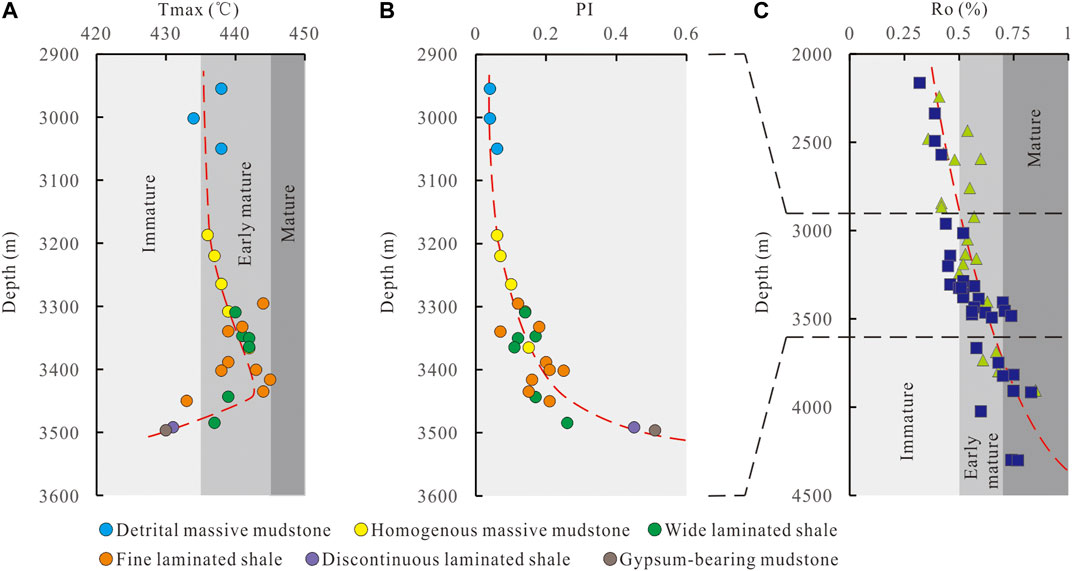
FIGURE 6. Tmax, PI and Ro versus depth profiles. (A) Tmax-depth. Tmax values slightly increased with increasing depth above 3,450 m, but beneath 3,450 m, the Tmax trend reversed, indicating suppression of Tmax. (B) PI = S1/(S1+S2) versus depth plot. Samples with higher PI values usually showed lower Tmax values (Wang et al., 2015). (C) Ro-depth. There was a good positive trend with Ro values increasing as expected with increasing depth. The green triangle data come from Li (2011), and the blue square data come from the database of the Shengli Oil Company.
Soluble Organic Matter and Group Components
Significant differences in the absolute contents of SOM and group components can be found among the shale samples with different lithofacies (Figure 7; Supplementary Table S3): 1) The content comparison of SOM, saturates and total hydrocarbons (THC) revealed generally similar trends, e.g., detrital massive mudstone < homogenous massive mudstone < wide laminated shale < discontinuous laminated shale < fine laminated shale < gypsum-bearing mudstone (Figures 7A,B,F). 2) For aromatics, the content comparison showed the order of detrital massive mudstone < homogenous massive mudstone < wide laminated shale < fine laminated shale < discontinuous laminated shale < gypsum-bearing mudstone (Figure 7C). 3) The content comparison of resins showed the order of detrital massive mudstone < homogenous massive mudstone ≈ discontinuous laminated shale < wide laminated shale < fine laminated shale ≈ gypsum-bearing mudstone (Figure 7D). 4) For asphaltenes, the content comparison showed the trend that detrital massive mudstone < discontinuous laminated shale < homogenous massive mudstone < wide laminated shale < fine laminated shale < gypsum-bearing mudstone (Figure 7E).
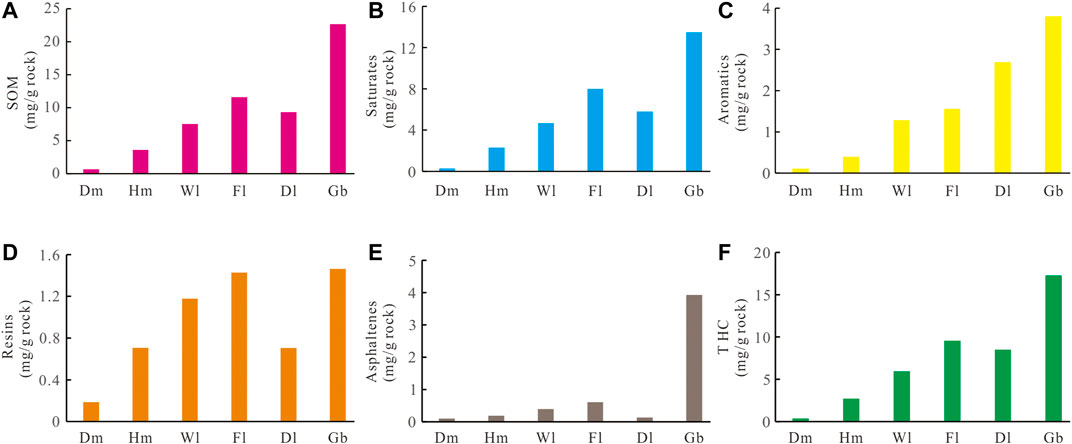
FIGURE 7. Average absolute contents of SOM and group components in shales with different lithofacies.
From the relative contents of SOM components in shales with different lithofacies, remarkable differences can be seen (Figure 8): 1) In the SOM in the detrital massive mudstone, saturates (average of 34.8%) and resins (average of 31.0%) were the main components, followed by aromatics (average of 19.7%) and asphaltenes (average of 14.5%). 2) In the SOM in the homogenous massive mudstone, saturates (average of 63.6%) were the main component. The percentage of resins (average of 19.9%) was higher than that of aromatics (average of 11.4%). The percentage of asphaltenes (average of 5.1%) was the lowest. 3) In the SOM in the wide laminated shale, saturates (average of 62.2%) were the main component. The percentage of aromatics (average of 16.5%) was roughly the same as that of resins (average of 15.9%). The percentage of asphaltenes (average of 5.4%) was the lowest. 4) In the SOM in the fine laminated shale, saturates (average of 68.2%) were the main component, followed by aromatics (average of 13.2%), resins (average of 13.4%), and finally asphaltenes (average of 5.2%). 5) In the SOM in the discontinuous laminated shale, saturates (62.2%) were the main component, followed by aromatics (28.9%). The percentages of resins (7.5%) and asphaltenes (1.4%) were very low, especially asphaltenes. 6) In the SOM in the gypsum-bearing mudstone, saturates (average of 59.5%) were the main component. The percentage of asphaltenes (17.3%) was roughly the same as that of aromatics (16.8%). The percentage of resins (6.4%) was the lowest.
Discussion
Control of Lithofacies on Soluble Organic Matter Content
The contents of SOM and group components in shale with different lithofacies were significantly different (Figure 7). Because the extracted SOM is most similar to crude oil in composition (Song et al., 2013; Liu et al., 2014), it is of great significance to understand the controlling effect of lithofacies on SOM. The differences among lithofacies were mainly present in sedimentary structure, mineral composition and organic characteristics (Figures 2–6). The SOM content in shale had a significant positive correlation with TOC and S1+S2 (Figures 9A,B), which indicated that the OM abundance and hydrocarbon generation potential of shale were important factors affecting the content of SOM. The massive mudstone had low OM abundance, low hydrocarbon generation potential and a poor OM type (Figures 4, 5), so the SOM content was low. However, the laminated shale had high OM abundance, high hydrocarbon generation potential and a better OM type (Figures 4, 5), resulting in a relatively high SOM content.
Among the different lithofacies, varying relationships between the SOM and minerals in shale were observed (Figures 9C–E). Overall, in the massive mudstone, the SOM content is negatively correlated with the contents of detrital and clay minerals, but positively correlated with the carbonate mineral content (Figures 9C–E). However, in the laminated shale, the SOM content has inverse relationships with mineral content (Figures 9C–E). Previous studies have indicated that the SOM extracted by organic solvents in shale is mainly free in pores and physically adsorbed onto mineral surfaces (Rumpel et al., 2005; Pan and Liu, 2009; Wei et al., 2014; Zhu et al., 2016). Moreover, different minerals in shale have various contributions to shale pores and surfaces, in which SOM can exist. For example, quartz and carbonates may act as a rigid framework for pores (Loucks et al., 2012), carbonate cements may reduce the pore surface area and pore volume (Gaines et al., 2012; Loucks et al., 2012), and clay minerals contribute positively to pore development (Slatt and O’Brien, 2011; Bennett et al., 2012; Zhu et al., 2019). In particular, carbonates in shales in the Dongying Sag clearly occur as cements (Deng and Liang, 2012; Zhang Y et al., 2016). Thus, high contents of detrital and clay minerals with a low content of carbonates in shale results in abundant shale pores and surfaces, promoting high SOM contents, and this phenomenon can be seen in the laminated shale (Figures 9C–E). However, the relationship between the SOM content and the mineral content in the massive mudstone is opposite that in the laminated shale (Figures 9C–E). This difference is attributed to the relatively poor conditions for OM preservation and enrichment, where the massive mudstone is interpreted to have been deposited close to the provenance under relatively strong water dynamics because the detrital minerals and clay minerals in the Dongying Sag are exogenous (Zeng et al., 2018). Consequently, the massive mudstone has low OM abundance and relatively low hydrocarbon generation potential (Figure 4). Therefore, the SOM content was controlled by lithofacies through differences in both OM and minerals.
Abundance of Shale Oil in Different Lithofacies
The oil saturation index (OSI = S1/TOC) is widely used to evaluate mobile shale oil, and the value of this parameter varies in different regions (Jarvie et al., 2007; Jarvie, 2012; Xue et al., 2015; Xie et al., 2016; Yu, et al., 2018; Li et al., 2020). By correlating OSI with the content of SOM, saturates and THC, positive correlations are present overall (Figure 10). However, the correlations in specific lithofacies are not very clear, which may be attributed to limiting sample sets. From the overall positive correlations (Figure 10), it seems that the contents of SOM, saturates or THC might be reliable indicators to evaluate the abundance of shale oil in shale with different lithofacies.
The composition of SOM free in the pores of shale is close to that of crude oil, and its content can effectively reflect the abundance of shale oil (Song et al., 2013; Liu et al., 2014). The contents of SOM, saturates and THC showed basically the same characteristics, that is, detrital massive mudstone < homogenous massive mudstone < wide laminated shale < discontinuous laminated shale < fine laminated shale < gypsum-bearing mudstone (Figure 7). Therefore, the abundance comparison of shale oil in different lithofacies showed that: 1) The contents of SOM, saturates and THC were very high in fine laminated shale, discontinuous laminated shale and gypsum-bearing mudstone, which were the relatively favorable lithofacies for shale oil exploration and development. 2) The contents of SOM, saturates and THC in the wide laminated shale were relatively high overall but low in some cases; thus, this lithofacies could also be a good target for shale oil exploration and development. 3) The detrital and homogenous massive mudstones, in which the contents of SOM, saturates and THC were relatively low, were relatively poor targets for shale oil exploration and development.
Quality of Shale Oil in Different Lithofacies
Shale oil is a mixture of hydrocarbons (mostly alkanes, cycloalkanes and aromatics) and other organic compounds containing nitrogen, oxygen, sulfur and traces of metals (Langevin and Argillier, 2016). Differences in the shale oil components affect the oil’s viscosity, which directly determines the oil quality and economic value. Previous studies have suggested that the viscosity of crude oil is proportional to the contents of resins and asphaltenes and is inversely proportional to the content of saturates (Liu and Guo, 2008; Wang et al., 2010; Gai, 2011; Zhang et al., 2014). Aromatics are conducive to the dispersion of asphaltenes, so the association of resins and asphaltenes can be dispersed in the saturates (Su and Zheng, 2007), thus contributing to the reduction of viscosity. These studies imply that an increase in the hydrocarbon content is beneficial to reducing the crude oil viscosity and thus improving the quality of crude oil, while the effect of resins and asphaltenes is the opposite. Based on this, we propose a parameter, the quality index (QI, QI = Contentsaturates+aromatics/Contentresins+asphaltenes), to judge the shale oil quality. Comparison of the QI values of different lithofacies revealed the following trend: detrital massive mudstone < homogenous massive mudstone < gypsum-bearing mudstone < wide laminated shale < fine laminated shale < discontinuous laminated shale (Figure 11A). Overall, the QI values of the discontinuous, fine and wide laminated shales were relatively high, and the quality of their shale oil was better.

FIGURE 11. Average QI and asphaltene percentage in shale with different lithofacies. (A) QI (Quality index, QI = Contentsaturates+aromatics/Contentresins+asphaltenes). (B) Asphaltene percentage.
From the percentage of asphaltenes in shale with different lithofacies (Figure 11B), great variations can be seen. The percentage of asphaltenes in the gypsum-bearing mudstone and detrital massive mudstone exceeded 10%. The percentage of asphaltenes in the wide and fine laminated shales and homogenous massive mudstone was approximately 5%. The percentage of asphaltenes in the discontinuous laminated shale was very low (less than 2%). As organic macromolecules, asphaltenes easily precipitate, accumulate, block pores, and chemically adsorb onto mineral surfaces (Mikami et al., 2013; Adebiyi and Thoss, 2014; Langevin and Argillier, 2016), the increase in content of which will not only reduce the SOM or crude oil quality, but also increase the difficulty of shale oil production. Thus, the differences in the percentage of asphaltenes of different lithofacies indicated that the quality of SOM or shale oil in the wide, fine and discontinuous laminated shales and homogenous massive mudstone was relatively good.
Therefore, combining the results from the QI value and asphaltene percentage, it can be concluded that the quality of shale oil in the discontinuous, fine and wide laminated shales was obviously better than that in the detrital and homogenous massive mudstones and gypsum-bearing mudstone.
Evaluation of Shale Oil “Sweet Spots”
Based on comparisons of the characteristics of SOM in shales with different lithofacies in the Dongying Sag, the shale oil in different lithofacies was evaluated from two aspects (abundance and quality) (Figure 12). Combining evaluations of abundance and quality in the comparison made it clear that the fine laminated shale, wide laminated shale and discontinuous laminated shale were the high-quality lithofacies, as these lithofacies had higher contents of SOM, THC or saturates, higher QI values, and lower asphaltene percentages.
From a large sample set of shale lithofacies (n = 234) distributed from Es4s to Es3z in the Dongying Sag, the comparison of the proportions of different lithofacies between submembers can indicate a relatively good target for shale oil exploration and development with optimization of high-quality lithofacies. After classification of different lithofacies, the proportions of different lithofacies in the submembers in the Dongying Sag were determined (Figure 13): 1) The shales in Es3z were mainly composed of detrital massive mudstone (65%) and homogenous massive mudstone (28%), and the proportion of laminated shale was less than 10%. 2) The shales in Es3x were mainly characterized by a lamellar structure. The proportions of fine laminated shale, wide laminated shale and discontinuous laminated shale were 39, 24 and 28%, respectively, and the proportion of massive mudstone was less than 10%. 3) More than 75% of the shales in Es4ss featured lamellar structures. The proportions of fine laminated shale, wide laminated shale and discontinuous laminated shale were 24, 43 and 12%, respectively, and the proportion of homogenous massive mudstone was 22%. 4) The shales in Es4sx were mainly composed of homogenous massive mudstone (65%) and gypsum-bearing mudstone (28%), and the remainder was laminated shale. From the perspective of lithofacies combinations, the shales in Es3z and Es4sx were mainly massive mudstone and gypsum-bearing mudstone, while the shales in Es3x and Es4ss were mostly laminated shale. Based on identification of high-quality lithofacies (i.e., the fine, wide and discontinuously laminated shales), the shales in Es3x and Es4ss were more favorable for shale oil development in the study area.
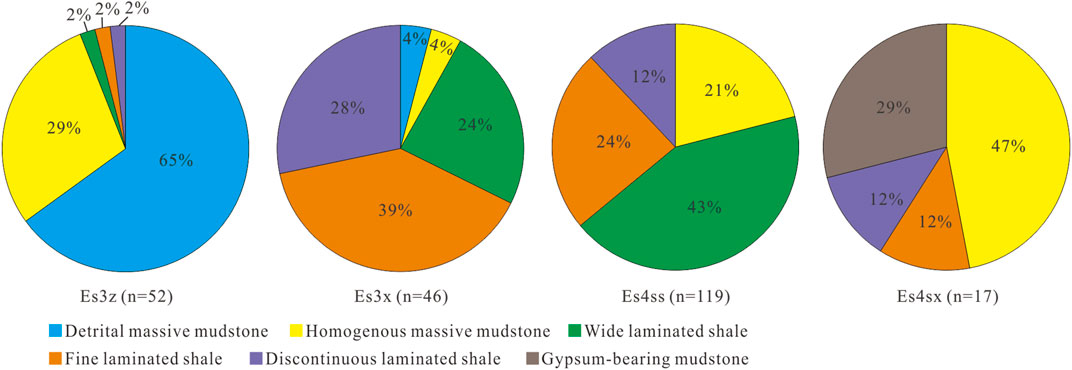
FIGURE 13. Lithofacies proportion of shales in different members. The data compile from Zeng et al., 2017.
Conclusion
1) In terms of the contents of SOM, saturates and THC, the lithofacies showed the order of detrital massive mudstone < homogenous massive mudstone < wide laminated shale < discontinuous laminated shale < fine laminated shale < gypsum-bearing mudstone. The relationships of the SOM content with pyrolysis parameters (TOC, S1+S2) and mineral content showed that the SOM content in shales with different lithofacies was mainly influenced by differences in mineral composition and organic characteristics. The SOM in the detrital massive mudstone and homogenous massive mudstone was mainly composed of saturates and resins, especially in the detrital massive mudstone. Saturates were the main component in the wide laminated shale and fine laminated shale. The SOM in the discontinuous laminated shale was mainly composed of saturates and aromatics. The SOM in the gypsum-bearing mudstone was mainly composed of saturates, and the percentage of asphaltenes was quite high.
2) Evaluation parameters were established to identify high-quality lithofacies and were based on abundance (i.e., the contents of SOM, THC and saturates) and quality (i.e., QI and asphaltene percentage). Comparisons of the evaluation parameters among different lithofacies showed that fine laminated shale, wide laminated shale and discontinuous laminated shale were high-quality lithofacies suitable for shale oil exploration and development, as these lithofacies had higher contents of SOM, THC or saturates, higher QI values, and lower asphaltene percentages.
3) From the perspective of lithofacies combination, the shales in Es3x and Es4ss, which were mainly laminated shales, were more favorable for shale oil development. The shales in Es3z and Es4sx, which were mainly massive mudstone and gypsum-bearing mudstone, were relatively poor targets. Therefore, it can be clearly defined that the fine laminated shale, wide laminated shale and discontinuous laminated shale in the Es3x and Es4ss in the Dongying Sag are “sweet spots” for shale oil exploration and development. It is of great significance for the exploration and development of shale oil to study the characteristics of SOM in shales with different lithofacies.
Data Availability Statement
The original contributions presented in the study are included in the article/Supplementary Material, further inquiries can be directed to the corresponding authors.
Author Contributions
JG and JH contributed to conception and design of the study. JH organized the database and performed the statistical analysis. JH wrote the first draft of the manuscript. JG and XZ revised and improved the manuscript. All authors contributed to manuscript revision, read, and approved the submitted version.
Funding
This work was financially supported by the National Natural Science Foundation of China (NSFC) (Grand No. 41972126), the Major Project of National Petroleum in China (Grand No. 2016ZX05006-001-003), and the Key Laboratory of Oil and Gas Reservoir Geology and Exploitation (Southwest Petroleum University) (Grand No. PLN201809).
Conflict of Interest
Authors MS, HL, and XW were employed by Shengli Oilfield Company.
The remaining authors declare that the research was conducted in the absence of any commercial or financial relationships that could be construed as a potential conflict of interest.
The handling Editor declared a past co-authorship with one of the authors HL.
Supplementary Material
The Supplementary Material for this article can be found online at: https://www.frontiersin.org/articles/10.3389/feart.2021.718596/full#supplementary-material
References
Abouelresh, M. O., and Slatt, R. M. (2012). Lithofacies and Sequence Stratigraphy of the Barnett Shale in East-central Fort Worth Basin, Texas. AAPG Bull. 96, 34–43. doi:10.1306/04261110116
Adebiyi, F. M., and Thoss, V. (2014). Organic and Elemental Elucidation of Asphaltene Fraction of Nigerian Crude Oils. Fuel 118, 426–431. doi:10.1016/j.fuel.2013.10.044
Bao, Y., Zhang, L., Zhang, J., Li, J., and Li, Z. (2016). Factors Influencing Mobility of Paleogene Shale Oil in Dongying Sag, Bohai Bay Basin. Oil Gas Geology. 37, 408–414. doi:10.11743/ogg20160314
Bennett, R. H., Bryant, W. R., Hulbert, M. H., Chiou, W. A., and Yamamoto, T. (2012). Microstructure of fine-grained Sediments: From Mud to Shale New York: Springer.
Chen, J. (2017). Research on the Movability of Shale Oil in Dongying Sag and the Optimization Method of Favorable Zone. East China: M.S. thesis China University of Petroleum.
Chen, Z., Jiang, W., Zhang, L., and Zha, M. (2018). Organic Matter, mineral Composition, Pore Size, and Gas Sorption Capacity of Lacustrine Mudstones: Implications for the Shale Oil and Gas Exploration in the Dongying Depression, Eastern China. Bulletin 102, 1565–1600. doi:10.1306/0926171423117184
Deng, M., and Liang, C. (2012). Studies on Reservoir Space of Mud Stone and Shale of the Lower Section of Es3 in Bonan Subsag: An Example from Well Luo 69. Earth Sci. Front. 19, 173–181.
Fu, J., Deng, X., Chu, M., Zhang, H., and Li, S. (2013). Features of deepwater Lithofacies, Yanchang Formation in Ordos Basin and its Petroleum Significance. Acta Sedimentologica Sinica 31, 928–938. doi:10.14027/j.cnki.cjxb.2013.05.011
Gai, P. (2011). The Relationship between the Viscosity and Fraction Characteristcs of the Heavy Oil of Shengli Oil Field. Oilfield Chem. 28, 54–57. doi:10.19346/j.cnki.1000-4092.2011.01.013
Gaines, R. R., Hammarlund, E. U., Hou, X., Qi, C., Gabbott, S. E., Zhao, Y., et al. (2012). Mechanism for Burgess Shale-type Preservation. Proc. Natl. Acad. Sci. 109, 5180–5184. doi:10.1073/pnas.1111784109
Hickey, J. J., and Henk, B. (2007). Lithofacies Summary of the Mississippian Barnett Shale, Mitchell 2 T.P. Sims Well, Wise County, Texas. Bulletin 91, 437–443. doi:10.1306/12040606053
Hou, L., Luo, X., Lin, S., Zhao, Z., and Li, Y. (2021b). Quantitative Measurement of Retained Oil in Organic-Rich Shale—A Case Study on the Chang 7 Member in the Ordos Basin, China. Front. Earth Sci. 9, 662586. doi:10.3389/feart.2021.662586
Hou, L., Ma, W., Luo, X., Liu, J., Liu, S., and Zhao, Z. (2021a). Hydrocarbon Generation-Retention-Expulsion Mechanism and Shale Oil Producibility of the Permian Lucaogou Shale in the Junggar Basin as Simulated by Semi-open Pyrolysis Experiments. Mar. Pet. Geology. 125, 104880. doi:10.1016/j.marpetgeo.2020.104880
Jarvie, D. M., Hill, R. J., Ruble, T. E., and Pollastro, R. M. (2007). Unconventional Shale-Gas Systems: The Mississippian Barnett Shale of north-central Texas as One Model for Thermogenic Shale-Gas Assessment. Bulletin 91, 475–499. doi:10.1306/12190606068
Jarvie, D. M. (2012). Shale Resource Systems for Oil and Gas: Part 2: Shale-Oil Resource Systems. AAPG Memoir 97, 89–119. doi:10.1306/13321446m973489
Kumar, S., Ojha, K., Bastia, R., Garg, K., Das, S., and Mohanty, D. (2017). Evaluation of Eocene Source Rock for Potential Shale Oil and Gas Generation in north Cambay Basin, India. Mar. Pet. Geology. 88, 141–154. doi:10.1016/j.marpetgeo.2017.08.015
Langevin, D., and Argillier, J.-F. (2016). Interfacial Behavior of Asphaltenes. Adv. Colloid Interf. Sci. 233, 83–93. doi:10.1016/j.cis.2015.10.005
Li, J. (2014). Oil and Gas Contents and Movable Oil Amounts of Shales in 4th Member of Shahejie Formation, Lijin Subsag, Dongying Sag. Pet. Geology. Exp. 36, 365–369. doi:10.11781/sysydz201403365
Li, W., Cao, J., Shi, C., Xu, T., Zhang, H., and Zhang, Y. (2020). Shale Oil in saline Lacustrine Systems: A Perspective of Complex Lithologies of fine-grained Rocks. Mar. Pet. Geology. 116, 104351. doi:10.1016/j.marpetgeo.2020.104351
Li, Y., Cai, J., Song, G., and Ji, J. (2015). DRIFT Spectroscopic Study of Diagenetic Organic-clay Interactions in Argillaceous Source Rocks. Spectrochimica Acta A: Mol. Biomol. Spectrosc. 148, 138–145. doi:10.1016/j.saa.2015.03.131
Li, Z. (2011). Exploration Potential Analyses of the Shale Gas in Dongying Depression. M.S. thesis Chengdu, China: Chengdu University of Technology.
Liang, C., Cao, Y., Liu, K., Jiang, Z., Wu, J., and Hao, F. (2018). Diagenetic Variation at the Lamina Scale in Lacustrine Organic-Rich Shales: Implications for Hydrocarbon Migration and Accumulation. Geochimica et Cosmochimica Acta 229, 112–128. doi:10.1016/j.gca.2018.03.017
Liu, B., He, J., Lv, Y., Ran, Q., Dai, C., and Li, M. (2014). Parameters and Method for Shale Oil Assessment: Taking Qinshankou Formation Shale Oil of Northern Songliao Basin. J. Cent. South Univ. (Science Technology) 45, 3846–3852.
Liu, H., and Guo, X. (2008). Influence of Property and Structure of Crude Oil on its Viscosity. Xinjiang Pet. Geology. 29, 347–349.
Loucks, R. G., Reed, R. M., Ruppel, S. C., and Hammes, U. (2012). Spectrum of Pore Types and Networks in Mudrocks and a Descriptive Classification for Matrix-Related Mudrock Pores. AAPG Bull. 96, 107–1098. doi:10.1306/08171111061
Loucks, R. G., and Ruppel, S. C. (2007). Mississippian Barnett Shale: Lithofacies and Depositional Setting of a Deep-Water Shale-Gas Succession in the Fort Worth Basin, Texas. Bulletin 91, 579–601. doi:10.1306/11020606059
Mikami, Y., Liang, Y., Matsuoka, T., and Boek, E. S. (2013). Molecular Dynamics Simulations of Asphaltenes at the Oil-Water Interface: From Nanoaggregation to Thin-Film Formation. Energy Fuels 27, 1838–1845. doi:10.1021/ef301610q
Misch, D., Gross, D., Mahlstedt, N., Makogon, V., and Sachsenhofer, R. F. (2016). Shale Gas/shale Oil Potential of Upper Visean Black Shales in the Dniepr-Donets Basin (Ukraine). Mar. Pet. Geology. 75, 203–219. doi:10.1016/j.marpetgeo.2016.04.017
Pan, C., Feng, J., Tian, Y., Yu, L., Luo, X., Sheng, G., et al. (2005). Interaction of Oil Components and clay Minerals in Reservoir Sandstones. Org. Geochem. 36, 633–654. doi:10.1016/j.orggeochem.2004.10.013
Pan, C., and Liu, D. (2009). Molecular Correlation of Free Oil, Adsorbed Oil and Inclusion Oil of Reservoir Rocks in the Tazhong Uplift of the Tarim Basin, China. Org. Geochem. 40, 387–399. doi:10.1016/j.orggeochem.2008.11.005
Rumpel, C., Seraphin, A., Dignac, M.-F., Michaelis, W., Eusterhues, K., and Kögel-Knabner, I. (2005). Effect of Base Hydrolysis on the Chemical Composition of Organic Matter of an Acid forest Soil. Org. Geochem. 36, 239–249. doi:10.1016/j.orggeochem.2004.08.001
Seville, J. P. K., Willett, C. D., and Knight, P. C. (2000). Interparticle Forces in Fluidisation: A Review. Powder Tech. 113, 261–268. doi:10.1016/s0032-5910(00)00309-0
Slatt, R. M., and O'Brien, N. R. (2011). Pore Types in the Barnett and Woodford Gas Shales: Contribution to Understanding Gas Storage and Migration Pathways in fine-grained Rocks. Bulletin 95, 2017–2030. doi:10.1306/03301110145
Song, G., Zhang, L., Lu, S., Xu, X., Zhu, R., Wang, M., et al. (2013). Resource Evaluation Method for Shale Oil and its Application. Earth Sci. Front. 20, 221–228.
Su, T., and Zheng, Y. (2007). Correlation between Heavy Oil Composition and its Viscosity. J. Yangtze Univ. Nat. Sci. Edition 4, 60–62. doi:10.16772/j.cnki.1673-1409.2007.01.019
Wang, E., Feng, Y., Liu, G., Chen, S., Wu, Z., and Li, C. (2021). Hydrocarbon Source Potential Evaluation Insight into Source Rocks-A Case Study of the First Member of the Paleogene Shahejie Formation, Nanpu Sag, NE China. Energ. Rep. 7, 32–42. doi:10.1016/j.egyr.2020.11.099
Wang, E., Liu, G., Pang, X., Li, C., Zhao, Z., Feng, Y., et al. (2020). An Improved Hydrocarbon Generation Potential Method for Quantifying Hydrocarbon Generation and Expulsion Characteristics with Application Example of Paleogene Shahejie Formation, Nanpu Sag, Bohai Bay Basin. Mar. Pet. Geology. 112, 104106. doi:10.1016/j.marpetgeo.2019.104106
Wang, M., Sherwood, N., Li, Z., Lu, S., Wang, W., Huang, A., et al. (2015). Shale Oil Occurring between Salt Intervals in the Dongpu Depression, Bohai Bay Basin, China. Int. J. Coal Geology. 152, 100–112. doi:10.1016/j.coal.2015.07.004
Wang, S., Shen, B., and Lin, R. (2010). Correlation for the Viscosity of Heavy Oil and its Chemical Composition. Acta PetroleiSinica: Pet. Process. Section 26, 795–799. doi:10.3969/j.issn.1001-8719.2010.05.023
Wang, Y., Wang, X., Song, G., Liu, H., Zhu, D. S., Zhu, D. Y., et al. (2016). Genetic connection between mud shale lithofacies and shale oil enrichment in Jiyang Depression, Bohai Bay Basin. Petroleum Exploration and Dev. 43, 696–704. doi:10.1016/s1876-3804(16)30091-x
Wang, Z., Zhang, Y., Liang, X., Cheng, F., Jin, Q., Liu, W., et al. (2014). Characteristics of shale lithofacies formed under different hydrodynamic conditions in the Wufeng-Longmaxi Formation, Sichuan Basin. Acta Petrolei Sinica 35, 623–632. doi:10.7623/syxb201404002
Wei, L., Mastalerz, M., Schimmelmann, A., and Chen, Y. (2014). Influence of soxhlet-Extractable Bitumen and Oil on Porosity in Thermally Maturing Organic-Rich Shales. Int. J. Coal Geology. 132, 38–50. doi:10.1016/j.coal.2014.08.003
Wei, Z., Zou, Y.-R., Cai, Y., Wang, L., Luo, X., and Peng, P. a. (2012). Kinetics of Oil Group-type Generation and Expulsion: An Integrated Application to Dongying Depression, Bohai Bay Basin, China. Org. Geochem. 52, 1–12. doi:10.1016/j.orggeochem.2012.08.006
Xie, X., Li, M., Littke, R., Huang, Z., Ma, X., Jiang, Q., et al. (2016). Petrographic and Geochemical Characterization of Microfacies in a Lacustrine Shale Oil System in the Dongying Sag, Jiyang Depression, Bohai Bay Basin, Eastern China. Int. J. Coal Geology. 165, 49–63. doi:10.1016/j.coal.2016.07.004
Xie, Z. (2009). Research on the Quaternary fine-fraction Lithofacies and Sedimentation Model in Tainan Area, Qaidam Basin. Earth Sci. Front. 16, 245–250. doi:10.1016/s1872-5791(08)60103-7
Xue, H., Tian, S., Lu, S., Zhang, W., Du, T., and Mu, G. (2015). Selection and Verification of Key Parameters in the Quantitative Evaluation of Shale Oil: A Case Study at the Qingshankou Formation, Northern Songliao Basin. Bull. Mineralogy, Pet. Geochem. 34, 70–78. doi:10.3969/j.issn.1007-2802.2015.01.008
Yang, W., Jiang, Y., and Wang, Y. (2015a). Study on Shale Facies Sedimentary Environment of Lower Es3-Upper Es4 in Dongying Sag. J. China Univ. Pet. 39, 19–26. doi:10.3969/j.issn.1673-5005.2015.04.003
Yang, Y., Lei, T., Guan, B., Tian, C., and Wu, Y. (2015b). Differences of Solvable Organic Matters with Different Occurrence States in Argillaceous Source Rocks of Coastal Shallow-lake Facie. Lithologic Reservoirs 27, 77–82. doi:10.3969/j.issn.1673-8926.2015.02.012
Yu, T., Lu, S., Li, J., and Zhang, P. (2018). Prediction for Favorable Area of Shale Oil Free Resources in Dongying Sag. Fault-Block Oil and Gas Field 25, 16–21. doi:10.6056/dkyqt201801004
Zeng, X., Cai, J., Dong, Z., Bian, L., and Li, Y. (2018). Relationship between mineral and Organic Matter in Shales: The Case of Shahejie Formation, Dongying Sag, China. Minerals 8, 222. doi:10.3390/min8060222
Zeng, X., Cai, J., Dong, Z., Wang, X., and Hao, Y. (2017). Sedimentary Characteristics and Hydrocarbon Generation Potential of Mudstone and Shale: a Case Study of Middle Submember of Member 3 and Upper Submember of Member 4 in Shahejie Formation in Dongying Sag. Acta Petrolei Sinica 38, 31–43. doi:10.7623/syxb201701004
Zhang, J., Feng, Z., Fang, W., Huo, Q., Zhang, K., Li, J., et al. (2014). Crude-oil Hydrocarbon Composition Characteristics and Oil Viscosity Prediction in the Northern Songliao Basin. Sci. China: Earth Sci. 44, 1324–1339. doi:10.1007/s11430-013-4656-8
Zhang, J., Jiang, Z., Jiang, X., Wang, S., Liang, C., and Wu, M. (2016). Oil Generation Induces Sparry Calcite Formation in Lacustrine Mudrock, Eocene of east China. Mar. Pet. Geology. 71, 344–359. doi:10.1016/j.marpetgeo.2016.01.007
Zhang, L., Li, Z., Li, J., Zhu, R., and Sun, X. (2012). Feasibility Analysis of Existing Recoverable Oil and Gas Resource in the Palaeogene Shale of Dongying Depression. Nat. Gas Geosci. 23, 1–13. doi:10.11764/j.issn.1672-1926.2012.01.1
Zhang, L., Li, Z., Zhu, R., Li, J., and Zhang, L. (2008). Resource Potential of Shale Gas in Paleogene in Jiyang Depression. Nat. Gas Industry 28, 26–29. doi:10.3787/j.issn.1000-0976.2008.12.006
Zhang, L., Liu, Q., Zhu, R., Li, Z., and Lu, X. (2009). Source Rocks in Mesozoic-Cenozoic continental Rift Basins, east China: A Case from Dongying Depression, Bohai Bay Basin. Org. Geochem. 40, 229–242. doi:10.1016/j.orggeochem.2008.10.013
Zhang, S., Chen, S., Yan, J., Tan, J., Zhang, Y., Gong, W., et al. (2015). Characteristics of Shale Lithofacies and Reservoir Space in the 3rd and 4th Members of Shahejie Formation, the West of Dongying Sag. Nat. Gas Geosci. 26, 320–332. doi:10.11764/j.issn.1672-1926.2015.02.0320
Zhang, S., Zhang, L., Li, Z., and Hao, Y. (2012). Formation Conditions of Paleogene Shale Oil and Gas in Jiyang Depression. Pet. Geology. Recovery Efficiency 19, 1–6. doi:10.13673/j.cnki.cn37-1359/te.2012.06.001
Zhang, Y., Chen, S., Sun, J., Ma, Y., Liu, C., Li, Z., et al. (2016). Lithofacies and Sedimentary Environment of Shale in Carboniferous Keluke Formation, Northern Qaidam Basin. Earth Sci. Front. 23, 86–94. doi:10.13745/j.esf.2016.05.009
Zhu, X., Cai, J., Liu, Q., Li, Z., and Zhang, X. (2019). Thresholds of Petroleum Content and Pore Diameter for Petroleum Mobility in Shale. Bulletin 103, 605–617. doi:10.1306/0816181617517009
Zhu, X., Cai, J., Liu, W., and Lu, X. (2016). Occurrence of Stable and mobile Organic Matter in the clay-sized Fraction of Shale: Significance for Petroleum Geology and Carbon Cycle. Int. J. Coal Geology. 160-161, 1–10. doi:10.1016/j.coal.2016.03.011
Keywords: shale, soluble organic matter, lithofacies, shale oil, sweet spots
Citation: He J, Cai J, Zhu X, Song M, Liu H, Wang X and Zeng X (2021) The Role of Soluble Organic Matter in Shale Oil “Sweet Spots” Prediction: An Investigation of Shale With Different Lithofacies in the Dongying Sag. Front. Earth Sci. 9:718596. doi: 10.3389/feart.2021.718596
Received: 01 June 2021; Accepted: 09 July 2021;
Published: 21 July 2021.
Edited by:
Min Wang, China University of Petroleum (Huadong), ChinaReviewed by:
Enze Wang, Peking University, ChinaLianhua Hou, Research Institute of Petroleum Exploration and Development (RIPED), China
Copyright © 2021 He, Cai, Zhu, Song, Liu, Wang and Zeng. This is an open-access article distributed under the terms of the Creative Commons Attribution License (CC BY). The use, distribution or reproduction in other forums is permitted, provided the original author(s) and the copyright owner(s) are credited and that the original publication in this journal is cited, in accordance with accepted academic practice. No use, distribution or reproduction is permitted which does not comply with these terms.
*Correspondence: Jingong Cai, jgcai@tongji.edu.cn; Xiaojun Zhu, xjzhu@tongji.edu.cn
 Jinyi He
Jinyi He Jingong Cai
Jingong Cai Xiaojun Zhu1*
Xiaojun Zhu1* 